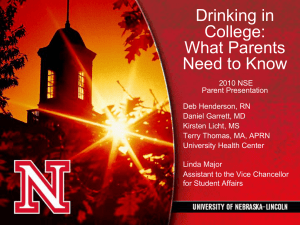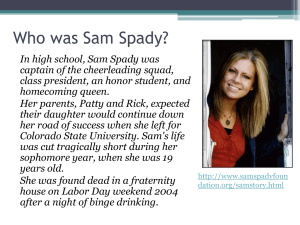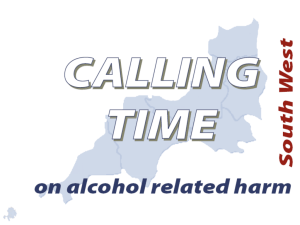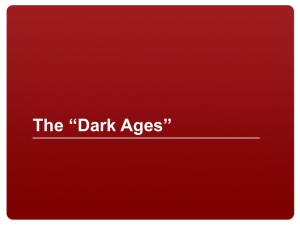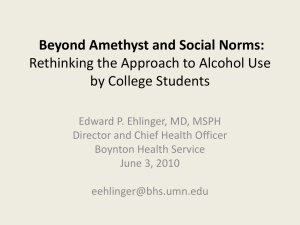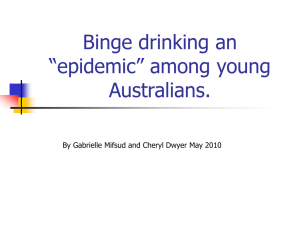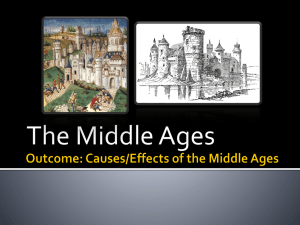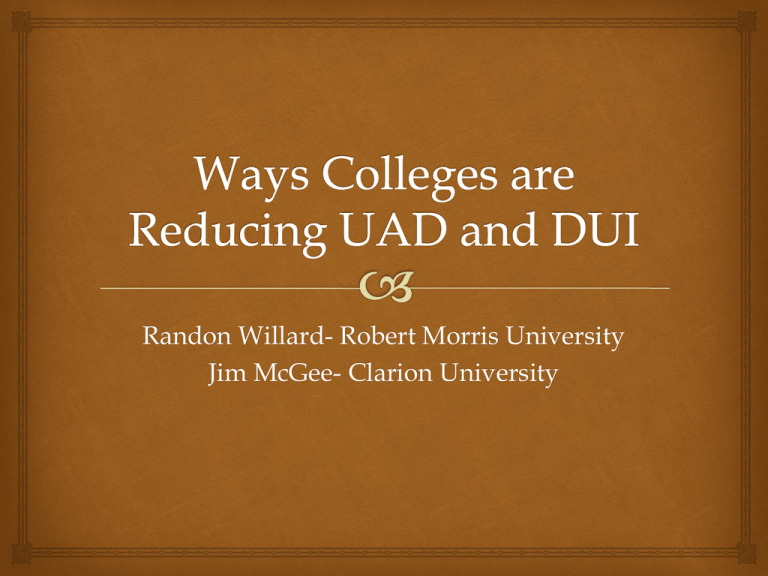
Randon Willard- Robert Morris University
Jim McGee- Clarion University
Scope of the Problem
CORE National Data for 2011 (50,505 students)
o 81.4% of student consumed alcohol in the past year
o 69.0% of students consumed alcohol in the past 30 days
o 63.4% of underage students (younger than 21) consumed
alcohol in the previous 30 days.
o 44.8% of student reported binge drinking in the previous two
weeks. A binge is defined as consuming 5 or more drinks in
one sitting.
Consequences of Underage Drinking
CORE National Data for 2011 (50,505 students)
o 33.0% reported some form of public misconduct (such as
trouble with police, fighting/arguments, DWI/DUI,
vandalism) at least once during the past year as a result of
drinking or drug use.
o 22.0% reported experiencing some kind of serious personal
problems (such as suicidality, being hurt or injured, trying
unsuccessfully to stop using, sexual assault) at least once
during the past year as a result of drinking or drug use.
Consequences Continued
National Institute on Alcohol Abuse and Alcoholism (NIAAA)
o
o
o
o
o
Death: Each year an estimated 1,825 college students between the ages
of 18 and 24 die from alcohol-related unintentional injuries, including
motor vehicle crashes.1
Injury: Each year an estimated 599,000 students between the ages of 18
and 24 are unintentionally injured under the influence of alcohol.1
Assault: Each year an estimated 696,000 students between the ages of
18 and 24 are assaulted by another student who has been drinking.1
Sexual Abuse: Each year an estimated 97,000 students between the
ages of 18 and 24 are victims of alcohol-related sexual assault or date
rape.1
Unsafe Sex: Each year an estimated 400,000 students between the ages
of 18 and 24 have unprotected sex, and more than 100,000 students
between the ages of 18 and 24 report having been too intoxicated to
know if they consented to having sex.2
Consequences Continued
o Academic Problems: About one-quarter of college students
report having academic consequences because of their
drinking, including missing class, falling behind, doing poorly
on exams or papers, and receiving lower grades overall.3–6
o Alcohol Abuse and Dependence: Nineteen percent of college
students between the ages of 18 and 24 met the criteria for
alcohol abuse or dependence, but only 5 percent of these
students sought treatment for alcohol problems in the year
preceding the survey.7
o Drunk Driving: Each year an estimated 3,360,000 students
between the ages of 18 and 24 drive under the influence of
alcohol.1
o Other Consequences: These include suicide attempts, health
problems, vandalism, property damage, and involvement with
the police.
Why are Students Using?
CORE National Data for 2011 (50,505 students)
o 74.4% said it breaks the ice and enhances a social
activity
o 71.7% say it gives people something to do
o 66.5% say it gives them something to talk about
o 53.0% say it facilitates sexual opportunity
What approach works?
Research shows that a multi-faceted approach works
the best which engages:
o
o
o
o
o
Individual students
Students as a whole
Faculty/Staff
Parents
Community
Individuals
o Campus Clarity
o First Year Experience
o Step Up
o Thrive Leaders
o Alcohol 101 & 102
o Student Programming
What messages will students
listen to?
o
o
o
o
Harm reduction strategies
Education and future
Values, behavior and character
Legacy as a leader
Students as a Whole
o
o
o
o
Social norms campaigns
Partnerships with local treatment centers
Hero Campaign for Designated Driving
Enforcement of policies
Faculty & Staff
o At Risk Website
o Student’s in Distress
Brochure
o Early Alert Form
Parents
o “Have you had the
conversation?” letter
o Training during orientation
Evaluating Efforts
How do you know what’s working?
o CORE survey (short or long form)
o Campus Clarity data/follow up
Good Neighbor Program
Creation
o Fall 2009 (PLCB Conference)
o Neighborhood Watch Program
o Negative Relationships between community
members and Students
Scope of the Problem
Quality of life concerns
o
o
o
o
o
o
o
o
o
o
Noise
Fights
Walking in large groups
Property damage
Debris
Large scale parties
Signs
Vandalism
Theft
Parking
NIAAA TASK FORCE
GOALS
o
o
o
Provide research-based information about the
nature and extent of dangerous drinking
Offer recommendations to college and university
presidents on the potential effectiveness of current
strategies to reverse the culture of drinking on
campus
Offer recommendations to the research
community, including NIAAA, for future research
on preventing hazardous college student drinking.
BASICS - Alcohol Abuse
Prevention
Tier 1- Evidence of
Effectiveness
o Combinations of cognitive-behavioral skills training
with norms clarification and motivational enhancement
interventions.
o Brief motivational enhancement interventions.
o Interventions challenging alcohol expectancies.
www.pubs.niaaa.nih.gov
Tier 2- Evidence of success
o Implementation, increased publicity, and enforcement
of laws to prevent alcohol-impaired driving.
o Restrictions on alcohol retail outlet density.
o Increased prices and excise taxes on alcoholic
beverages.
o Responsible beverage service policies in social and
commercial settings.
o Campus and community coalitions of all major
stakeholders to implement these strategies effectively.
www.pubs.niaaa.nih.gov
Tier 3- Evidence of promise,
but needs more research
“Social norms marketing” or normative education.
Consistent enforcement of campus alcohol policies.
Safe rides for students who drink too much to drive.
Regulation of happy hour promotions.
Information for new students and their parents
about alcohol use and campus policies.
o Other strategies: Alcohol-free residence halls and
social activities and scheduling classes on Fridays to
reduce Thursday night parties.
www.pubs.niaaa.nih.gov
o
o
o
o
o
Tier 4- “Evidence of ineffectiveness”
o Simple education/awareness tables or programs
used alone
www.pubs.niaaa.nih.gov
Culture ChangeEnvironmental Strategy
Approaching Key Stakeholders
o Resurgence of alcohol task force
o Reaching out to community members, bar owners,
zoning office and property owners
o Student Involvement- Student Senate
o Quarterly Meetings
Focus was placed on underage/harmful drinking
Key Constituents
Office of Residence Life and Community Assistants
Center for Leadership and Involvement
Clarion University President/VP of Student Affairs
Student Senate
Judicial Services
Members of the Alcohol Task Force
Coordinator of Health Promotions
Athletic Department
Local property owners/landlords
PSP, PLCE, Borough Police, University Police, Sheriff's
Department
o Passages
o
o
o
o
o
o
o
o
o
o
Creating a Good Neighbor
Identity
o Marketing/Branding
o Social Norming
o Letter from the President
o Letter to the community members
o Logo
o GN Poster- Local Businesses
http://www.clarion.edu/267773/
Program Design
o The spirit of the program is to be intentional and
developmental with students and their community
members
o Fall 2009 Pushback
Fines VS. Relationship Building
Program Design- Continue
o Identified targeted areas- Zoning Office (Maps)
o May change each year due to student residence
o All Freshman- LCE Discovery Weekend
o Four Walk-throughs- Strategic to times of year
o Social norming material flooding during 1st walkthrough (PLCB materials)
Program Design- Continue
o
o
o
o
Additional walk-throughs- Concerns
Students (interns) conduct students stops
Pre/post Survey- community members and students
4 Task force meetings and 2 law enforcement
Funding
o Pennsylvania Liquor Control Board Grant
o Department budgets cover speaker series and pool
parties
Findings
o
o
o
o
Complaints have increased as well as noise citations
Shift in targeted areas
Decrease in large scale parties
Increase in relationships- Law enforcement
o Red cup party
o Dietz trash
o Beer Tree
Findings
Findings
Walk-throughs
Findings
Question- Community Survey
Have you been an active participant in the Good Neighbor
Program prior to this academic year?
How much of a problem are alcohol related parties in your
neighborhood?
How much of a problem is public intoxication in your
neighborhood?
How much of a problem is property damage in your
neighborhood?
How much of a problem are noise disturbances in your
neighborhood?
2012 Pre Results
6% Yes
2013 Pre Results
54% Yes
37%- Moderate
Problem
27%- Moderate
Problem
41%- Not a
problem
26%- Serious
Problem
20% Moderate
Problem
17%- Moderate
Problem
33%- Not a
problem
35%- Serious
Problem
Question- Student Survey
General perceptions of how much public intoxication is a problem
in your neighborhood.
How much of a problem are noise disturbances in your
neighborhood?
2012 Pre Results
47%%- Not a
problem
29%- Minor
Problem
2013 Pre Results
58%- Not a
problem
37% Minor
Problem
Assessment
o
o
o
o
Surveys
Focus Groups
Open Communication
Focus on creating balance
Pre-Survey Community
comments:
o None necessary, university and local enforcement
personnel appear to cooperate to assure amicable
relationship between community and university.
o My main concern is the lack of respect shown by
students to the citizens of Clarion. Some show no
respect for the property of others.
Pre-Survey Community
comments:
o Landlords should take more responsibility for their
tenants behavior.
o The Good Neighbor Program is wonderful, but I feel
that it needs to be truly put into action, and use as an
integral part of our society.
o More patrolling university police especially late
party nights Thurs. Friday Sat. all day
Post-Survey Community
comments:
o No real problems in neighborhood (property
damage)
o There was no public intoxication that caused
problems (public intox)
o I truly appreciate the efforts of the committee! Time
and energy away from family (overall)
Post-Survey Community
comments:
o Although it may be difficult to arrange, it would be
nice for a neighborhood get together, for residents to
meet the students at the start of the semester.
o Still throwing trash (beer cans, cigarette butts, etc. in
my yard; still trespassing on my property
o Great Work
Questions Campus Leaders Should Ask
1. What type of problem needs to be addressed (e.g., high rates of heavy drinking, fights during
sporting events, underage drinking)?
2. What strategy is most likely to address each problem?
3. At what level should the strategy be implemented (e.g., at sports stadiums, campus-wide,
communitywide, Statewide)?
4. Who should participate in developing strategies? Who should participate at the start and who
should be brought in only after a supportive base for action is established?
5. What strategies are currently being implemented?
6. How well are existing policies being enforced?
7. Would enforcement of existing policies be more effective than implementing new policies?
8. How can environmental and individually focused approaches complement each other?
9. What resources are needed to implement new strategies? Are resources available?
10. How will new strategies be evaluated and fine-tuned to maximize their effect?
11. Are the students who need help most actually getting it? That is, are your interventions
reaching the students who need them the most?
12. Are your strategies founded on solid, research-based findings? And are those strategies
reaching the vast majority of your student population?
SOURCE: Material for this checklist originally appeared in Toomey, T.L., and Wagenaar, A.C. Environmental policies to reduce
college drinking: Options and research findings. Journal of Studies on Alcohol (Suppl.14):193–205, 2005, Updated January 2005
for NIAAA.
Resources
Hingson, R.W.; Zha, W.; and Weitzman, E.R. Magnitude of and trends in alcohol-related mortality and morbidity among
U.S. college students ages 18–24, 1998–2005. Journal of Studies on Alcohol and Drugs Supplement 16:12–20, 2009.
1
Hingson, R.W.; Heeren, T.; Zakocs, R.C.; et al. Magnitude of alcohol-related mortality and morbidity among U.S. college
students ages 18–24. Journal of Studies on Alcohol 63(2):136–144, 2002.
2
Engs, R.C.; Diebold, B.A.; and Hansen, D.J. The drinking patterns and problems of a national sample of college students,
1994. Journal of Alcohol and Drug Education 41(3):13–33, 1996.
3
Presley, C.A.; Meilman, P.W.; and Cashin, J.R. Alcohol and Drugs on American College Campuses: Use, Consequences, and
Perceptions of the Campus Environment, Vol. IV: 1992–1994. Carbondale, IL: Core Institute, Southern Illinois University, 1996.
4
Presley, C.A.; Meilman, P.W.; Cashin, J.R.; and Lyerla, R. Alcohol and Drugs on American College Campuses: Use,
Consequences, and Perceptions of the Campus Environment, Vol. III: 1991–1993. Carbondale, IL: Core Institute, Southern
Illinois University, 1996.
5
Wechsler, H.; Lee, J.E.; Kuo, M.; et al. Trends in college binge drinking during a period of increased prevention efforts:
Findings from four Harvard School of Public Health study surveys, 1993–2001. Journal of American College Health 50(5):203–
217, 2002.
6
National Institute on Alcohol Abuse and Alcoholism, National Epidemiologic Survey on Alcohol and Related
Conditions, 2002 (special data run).
7



